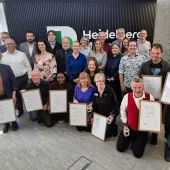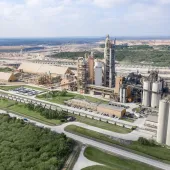RESTORE project progress celebrated at third partner meeting
Partners meet in Maastricht to report on and celebrate achievements in the first half of the project
EARLIER this year all seven RESTORE partners gathered together in Maastricht, Netherlands, for their third partner meeting. The partnership project between seven organizations across north-west Europe is co-financed by the EU Interreg IVB programme for the region and aims to develop a framework for restoring quarries to provide benefits for biodiversity, habitats and local people. This will help increase the sustainability of north-west Europe by reversing biodiversity declines, protecting and buffering designated nature sites, enhancing landscapes, providing green infrastructure and improving quality of life.
Signifying the half-way point in the project, the partners met in the room where the Maastricht Treaty was signed, to report on and celebrate the achievements so far, and to look forward to the works planned over the remainder of the project.
During the visit to the Province of Limburg, the partners were given a tour around four quarries, each differing vastly in scale and restoration ambitions. They comprised: a 43km long flood-alleviation scheme being realized through gravel extraction; a small limestone quarry used to provide local stone during World War 1 and which is now being enhanced for amphibian species; a large silica sand operation where local residents are being consulted over the proposed restoration; and a large cement quarry on the outskirts of Maastricht where the historic route between Maastricht and Liege is being reconnected as part of the quarry restoration.
Nature After Minerals (NAM), a partnership between Natural England and the RSPB, one of the RESTORE project partners, plans to share all the knowledge learnt on the trip with colleagues on this side of the Channel through a series of case studies, quarry demonstration events and conferences throughout 2014. Topics covered will include partnership working, landscape-scale conservation, floodplain forest creation, biodiversity enhancements within operational quarries and agricultural restorations, funding long-term aftercare, and using gravel extraction for flood management. Further details, including dates and locations, will be announced in due course.
In the meantime, see the Events section at the foot of this Bulletin for details of the RESTORE mid-term conference in June.









